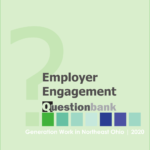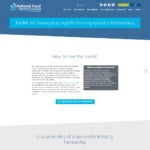Originally posted: May 11, 2020
Last updated: September 21, 2023
Section 3 is designed to support intermediary organizations that work with employers and want to build staff capacity to have conversations with business representatives that promote job quality. The resources below offer practical tools to strengthen employer engagement and make the business case for improving job quality.
Many workforce and economic development organizations are new to having conversations with employers about improving jobs. Building this practice requires preparing staff to ask new kinds of questions about business operations and workforce practices and to demonstrate the value that strengthening job quality can bring to employers.
↓ Tools and Resources Below the Box ↓
Library Navigation
- Job Quality Tools Library Homepage
- About This Library
- Special: COVID-19 Response Tools and Resources
- Index of Tools by Field
Business Value Assessments to Make the Case for Job Quality

The Aspen Institute Economic Opportunities Program – Cost of Turnover Tool
Who’s It For: Employers, Economic Development, Investing and Lending, Policy, Worker Advocacy, Workforce Development
What’s It For: To make the business case for improving retention, employers can use this simple calculator to get a ballpark estimate of hard costs of turnover. Partners can complete this exercise with businesses to show the value of their services or talent management practices that reduce turnover. Unlike many other turnover calculators, this tool includes both direct costs, such as the cost of hiring or orientation, and indirect costs, such as lower employee morale or poorer customer service.

The Aspen Institute Economic Opportunities Program – Business Value Assessment Toolkit
Who’s It For: Employers, Workforce Development
What’s It For: This handbook offers guidance and instructions for using a set of tools to measure the value that a workforce development organization delivers to its business clients, such as through improved productivity and skills. This business value assessment begins with planning for the assessment and then using the included Excel tool and questionnaires to complete the assessment. It also includes information about why these assessments are valuable, potential limitations, and who should be included in the process, along with case studies that describe how workforce service providers partnered with businesses to measure results.
Capacity Building Tools to Strengthen Employer Engagement

Who’s It For: Employers, Workforce Development, Worker Advocacy
What’s It For: This guide contains tips and practices for creating trusted relationships with small business employers focused on improving job quality, and compiles seven lessons for small business prospecting, recruitment, and ongoing engagement. Lessons outlined in this publication were developed as part of the Economic Opportunities Program’s Reimagine Retail job quality research, and in response to a growing demand for employer engagement practices that enable collaboration and innovative solutions in connecting people to good jobs. Although there is no one-size-fits-all approach to developing relationships with employers, this tool may be of interest to employers (and their partners) who would like to engage in job quality discussions and tailor engagement to their local contexts.

Who’s It For: Workforce Development
What’s It For: This question bank includes targeted questions that workforce development professionals can ask retail business representatives to have learning-focused conversations and deepen relationships. The tool includes questions to help understand a business and its workforce, employee engagement, development and advancement in a firm, and wages and scheduling practices.

Generation Work / Cuyahoga County – Employer Engagement Question Bank
Who’s It For: Worker Advocacy, Workforce Development
What’s It For: The Employer Engagement Question Bank is designed to help workforce professionals engage in conversations with businesses to support the jobseekers they work with. This tool can be used for learning about a business with an eye toward providing workforce services, developing expertise about industry norms and practices, and building relationships that build credibility in discussions about strategies for promoting worker retention and advancement. The tool includes questions to build understanding of the business, its workforce needs, and a range of job quality factors including compensation, opportunities for advancement, and equity and inclusion. Workforce development and other professionals that support workers can adapt the tool to meet their employer engagement goals.

National Fund for Workforce Solutions – Toolkit for Developing High-Performing Industry Partnerships
Who’s It For: Employers, Economic Development, Workforce Development
What’s It For: This tool is designed to guide workforce practitioners through the development and growth of industry partnerships that bring together employers, service providers, and workers. While industry partnerships may form to address talent needs, as the National Fund notes, these partnerships can become an important avenue for addressing job quality and workplace inequities over time. The toolkit includes an assessment to help strengthen partnerships as well as guidance and resources related to five areas: employer and industry engagement; stakeholder engagement; data-informed strategy and continuous learning; operational capacity; and racial equity and inclusion. Workforce and economic development may find the toolkit useful to embed job quality in industry partnership approaches.

Reimagine Retail Chicagoland – Reimagining Employer Engagement: A Toolkit for Providers
Who’s It For: Workforce Development
What’s It For: Workforce development practitioners can use this how-to guide to build capacity to strengthen relationships with employers. It includes instructions on researching employers and labor markets, preparing for meetings with employers, talking about job quality, pitching services, and deepening employer relationships.
Supplemental Resources: Capacity Building Tools to Strengthen Employer Engagement
- JFF – Become an Impact Employer – Prepare Your Company for the Future of Work by Putting Talent First. This publication provides the business case for adopting practices that make a positive impact on workers, such as employee development, and provides examples of businesses implementing these practices. Workforce development professionals and other practitioners can use this resource to develop job quality language and framing that may resonate in many corporate environments.
- National Fund for Workforce Solutions – Job Quality Learning Reports. This series, informed by local job quality initiatives, can support workforce development professionals interested in beginning or strengthening engagement with employers to improve job quality. The reports are organized around three areas: 1) Strategies for Resourcing Job Quality Initiatives, with a focus on co-investment strategies with employers; 2) Practitioner competencies that can support staff engaged in job quality efforts with employers; and 3) Employer readiness characteristics to consider when determining employer partners. This last report also includes a link to a resource to help practitioners navigate employer resistance to change efforts. This series may also be useful for others interested in partnering on local job quality efforts, including economic development professionals and employers.